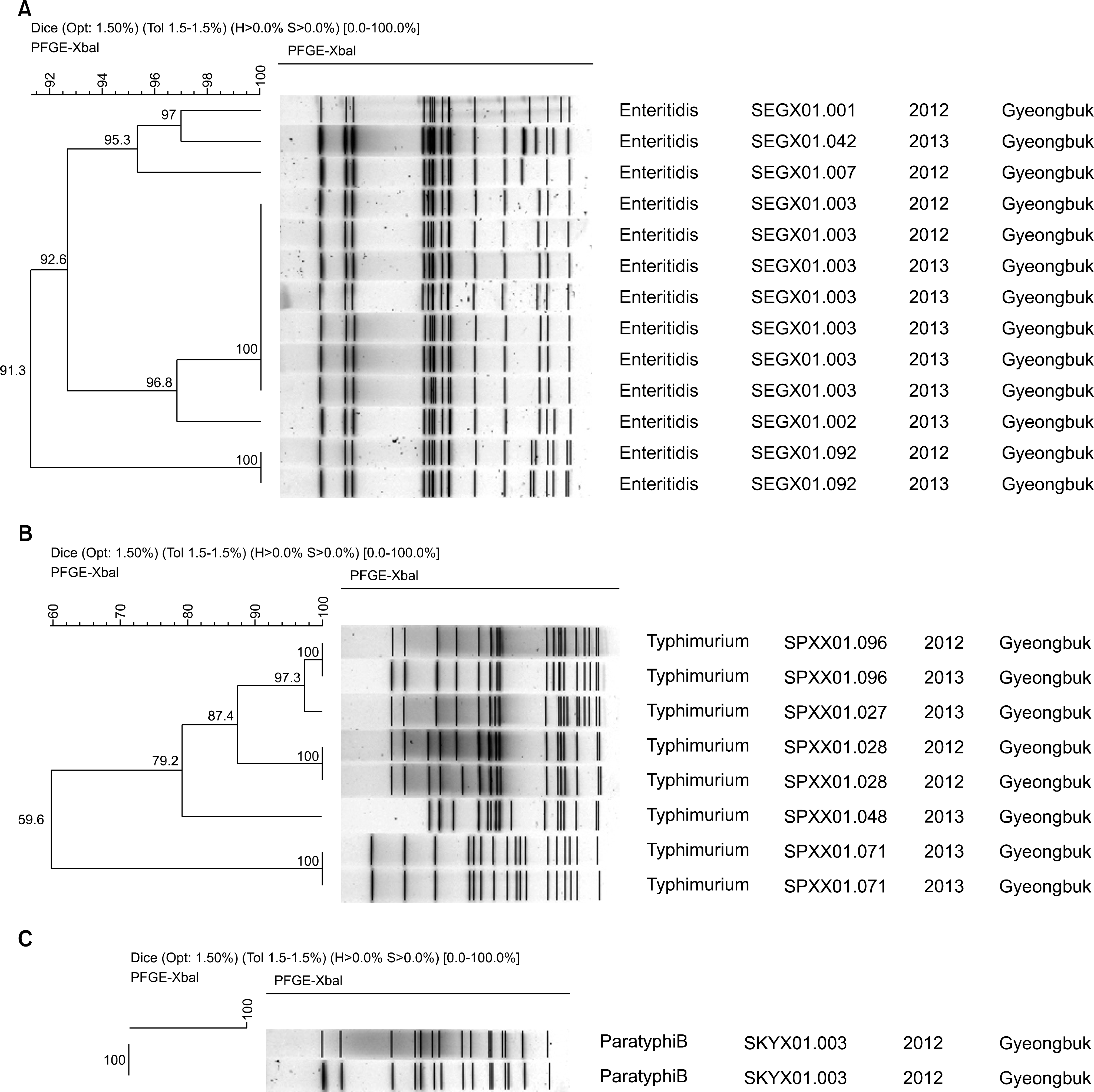초록
Background
Extended-spectrum cephalosporins and fluoroquinolones are important antimicrobials for treat-ing invasive salmonellosis, and emerging resistance to these antimicrobials is of paramount concern.
Methods
A total of 30 Salmonella spp. clinical isolates recovered in Gyeongsangbuk-do from 2012 to 2013 were characterized using antibiotic resistance profiles and pulsed-field gel electrophoresis (PFGE).
Results
A high prevalence of multidrug-resistant isolates, mainly showing an ampicillin, nalidixic acid, chloramphenicol resistance pattern, was observed. Four extended-spectrum β-lactamase (ESBL)-producing isolates (3 CTX-M-15 isolates and 1 CTX-M-27 iso-late) were found. The blaCTX-M-27 gene was carried by an IncF conjugative plasmid in the S. Infantis isolate. The blaCTX-M-15 gene were carried by an IncF (2 isolates) or IncHI2 (1 isolate) conjugative plasmid in S. Enteritidis. In addition, a single mutation of GyrA, Ser83Thr (1 isolates), Asp87Tyr (9 isolates), Asp87Gly (4 isolates), and Asp87Leu (3 isolates), was detected in nalidixic acid-resistant Salmonella spp. isolates. XbaI PFGE analysis of all isolates revealed more than 19 different pulsotypes. The most common S. Enteritidis PFGE pattern (SEGX01.003) was associated with a larger number of cases of invasive salmonellosis than all other patterns.
Go to : 
REFERENCES
1.Khakhria R., Woodward D., Johnson WM., Poppe C. Salmonella isolated from humans, animals and other sources in Canada, 1983-92. Epidemiol Infect. 1997. 119:15–23.
2.Jones TF., Ingram LA., Cieslak PR., Vugia DJ., Tobin-D'Angelo M., Hurd S, et al. Salmonellosis outcomes differ substantially by serotype. J Infect Dis. 2008. 198:109–14.

3.Mermin J., Hutwagner L., Vugia D., Shallow S., Daily P., Bender J, et al. Emerging Infections Program FoodNet Working Group. Reptiles, amphibians, and human Salmonella infection: a population- based, case-control study. Clin Infect Dis. 2004. 38(Suppl 3):S253–61.
4.Kimura AC., Reddy V., Marcus R., Cieslak PR., Mohle-Boetani JC., Kassenborg HD, et al. Emerging Infections Program FoodNet Working Group. Chicken consumption is a newly identified risk factor for sporadic Salmonella enterica serotype Enteritidis infections in the United States: a case-control study in FoodNet sites. Clin Infect Dis. 2004. 38(Suppl 3):S244–52.
5.Scallan E., Hoekstra RM., Angulo FJ., Tauxe RV., Widdowson MA., Roy SL, et al. Foodborne illness acquired in the United States--major pathogens. Emerg Infect Dis. 2011. 17:7–15.

6.Gatto AJ., Peters TM., Green J., Fisher IS., Gill ON., O'brien SJ, et al. Distribution of molecular subtypes within Salmonella enterica serotype Enteritidis phage type 4 and S. Typhimurium definitive phage type 104 in nine European countries, 2000-2004: results of an international multi-centre study. Epidemiol Infect. 2006. 134:729–36.
7.Bradford PA. Extended-spectrum beta-lactamases in the 21st century: characterization, epidemiology, and detection of this important resistance threat. Clin Microbiol Rev. 2001. 14:933–51.
8.Oteo J., Aracil B., Alós JI., Gómez-Garcés JL. High rate of resistance to nalidixic acid in Salmonella enterica: its role as a marker of resistance to fluoroquinolones. Clin Microbiol Infect. 2000. 6:273–6.
9.McEwen SA., Fedorka-Cray PJ. Antimicrobial use and resistance in animals. Clin Infect Dis. 2002. 34(Suppl 3):S93–106.

10.Ewing WH. Edwards and Ewing's identification of Enterobacteriaceae. New York; Elsevier Science Publishing Co. Inc. 1986.
11.CLSI. Performance standards for antimicrobial susceptibility testing: twentieth informational supplement. Document M100-S20. Wayne, PA; Clinical and Laboratory Standards Institute. 2010.
12.Kim JY., Jeon SM., Rhie HG., Lee BK., Park MS., Lee H, et al. Rapid detection of extended spectrum β-lactamase (ESBL) for Enterobacteriaceae by use of a multiplex PCR-based method. Infect Chemother. 2009. 41:181–4.
13.Kim JS., Kim J., Kim SJ., Jeon SE., Oh KH., Cho SH, et al. Characterization of CTX-M-type extended-spectrum beta-lactamase- producing diarrheagenic Escherichia coli isolates in the Republic of Korea during 2008-2011. J Microbiol Biotechnol. 2014. 24:421–6.
14.Carattoli A., Bertini A., Villa L., Falbo V., Hopkins KL., Threlfall EJ. Identification of plasmids by PCR-based replicon typing. J Microbiol Methods. 2005. 63:219–28.

15.Casin I., Breuil J., Darchis JP., Guelpa C., Collatz E. Fluoroquinolone resistance linked to GyrA, GyrB, and ParC mutations in Salmonella enterica Typhimurium isolates in humans. Emerg Infect Dis. 2003. 9:1455–7.
16.CDC. Standardized laboratory protocol for molecular subtyping of Escherchia coli O157:H7, non-typhoidal Salmonella serotypes, and Shigella sonnei by Pulse-Field Gel Electrophoresis (PFGE). http://www.pulsenetinternational.org/assets/PulseNet/uploads/pfge/PNL05_Ec-Sal-ShigPFGEprotocol.pdf. [Online.] (last visited on 04 April 2014).
17.Hohmann EL. Nontyphoidal salmonellosis. Clin Infect Dis. 2001. 32:263–9.
18.Biedenbach DJ., Toleman M., Walsh TR., Jones RN. Analysis of Salmonella spp. with resistance to extended-spectrum cephal-osporins and fluoroquinolones isolated in North America and Latin America: report from the SENTRY Antimicrobial Surveillance Program (1997-2004). Diagn Microbiol Infect Dis. 2006. 54:13–21.
19.KARMS. Korean Antimicrobial Resistance Monitoring System. KCDC. 2011.
20.Colom K., Pérez J., Alonso R., Fernández-Aranguiz A., Lariño E., Cisterna R. Simple and reliable multiplex PCR assay for detection of bla TEM, bla SHV and bla OXA-1 genes in Enterobacteriaceae. FEMS Microbiol Lett. 2003. 223:147–51.
21.Melano R., Corso A., Petroni A., Centrón D., Orman B., Pereyra A, et al. Multiple antibiotic-resistance mechanisms including a novel combination of extended-spectrum beta-lactamases in a Klebsiella pneumoniae clinical strain isolated in Argentina. J Antimicrob Chemother. 2003. 52:36–42.
22.Hopkins KL., Liebana E., Villa L., Batchelor M., Threlfall EJ., Carattoli A. Replicon typing of plasmids carrying CTX-M or CMY beta-lactamases circulating among Salmonella and Escherichia coli isolates. Antimicrob Agents Chemother. 2006. 50:3203–6.
23.Tamang MD., Nam HM., Kim TS., Jang GC., Jung SC., Lim SK. Emergence of extended-spectrum beta-lactamase (CTX-M-15 and CTX-M-14)-producing nontyphoid Salmonella with reduced susceptibility to ciprofloxacin among food animals and humans in Korea. J Clin Microbiol. 2011. 49:2671–5.
Go to : 
Table 1.
MIC50 and MIC90 of antibiotics for Salmonella spp. isolates (n=30)
Table 2.
MICs of Salmonella spp. isolates
Abbreviations: AMP, Ampicillin; CRO, Ceftriaxone; CTX, Cefotaxime; FOX, Cefoxitin; SAM, Ampicillin/Sulbactam; AMC, Amoxicillin/ Clavulanic acid; IMP, Imipenem; AMK, Amikacin; GEN, Gentamicin; NAL, Nalidixic acid; CIP, Ciprofloxacin; TCY, Tetracycline; CHL, Chloramphenicol; SXT, Trimethoprim/Sulfamethoxazole. Values in boldface indicate higher value than the breakpoint of CLSI.
Table 3.
Molecular characteristics of Salmonella spp. resistant to third-generation cephalosporins and quinolones




 PDF
PDF ePub
ePub Citation
Citation Print
Print



 XML Download
XML Download